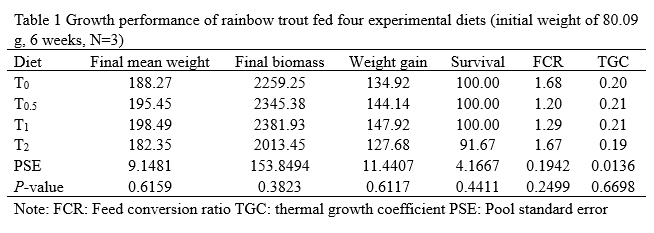RESPONSE OF GROWTH AND SALINITY ADAPTABILITY OF JUVENILE RAINBOW TROUT Oncorhynchus mykiss TO DIETARY SUPPLEMENTATION WITH TAURINE
In order to meet the demand of salmon market, Chinese scientists and entrepreneur are working on salmon mariculture far offshore in the Yellow Sea, China. Rainbow trout was selected as one of the main culture species for its vital economic value. The objective of this study is to evaluate the growth and salinity adaptability of rainbow trout in response to different dietary taurine levels. Four diets (45% protein, 16% lipid) were formulated with the supplementation of taurine at 0%, 0.5%, 1%, and 2% (abbreviated as T0, T0.5, T1, and T2) respectively.
Juvenile rainbow trout (N=3; 80.09 g initial weight) were fed the experimental diets for six weeks and subsequently underwent salinity acclimation. The fish were fed to apparent satiation twice (0830h and 1630h) daily and fed consumption was recorded. The fish were cultured in a non-circulating system with supplemental aeration. Water was changed by hand twice daily to allow an approximately 100% water exchange. At the end of the six-week period, all fish were weighted. After that, the freshwater was abrupt changed to brackish water with a salinity of 15 ppt by mixing with natural seawater, and salinity was increased to 30 ppt by a rate of 3 ppt per day. On days 1, 4, 7 and 14 after salinity acclimation as well as at the end of the growth trial, the serum osmolality, serum ion concentration, serum cortisol content, serum free amino composition, gill Na+, K+-ATPase (NKA) activity, liver superoxide dismutase (SOD) activity, liver catalase (CAT) activity, and muscle malondialdehyde (MDA) content were determined. At the end of the six-week growth trial, there were no significant differences in survival rate (91.67-100%), final weight (182.35-198.49 g), weight gain (127.68-147.92%) and FCR (1.20-1.68) (Table 1). All physiological data will be further analyzed and reported.
